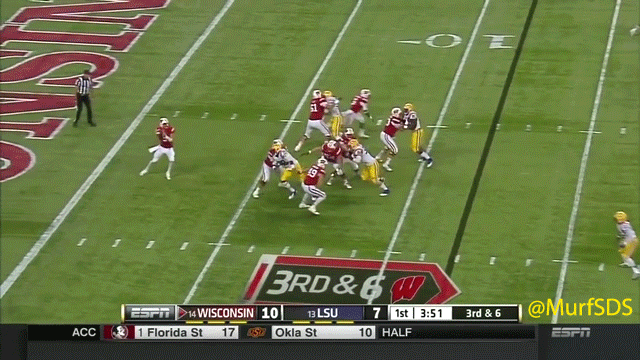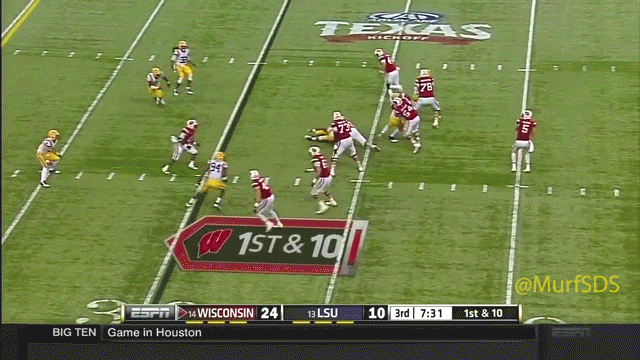LSU Football: DBs Collins and Mills will make a major impact for Tigers’ D
By Murf Baldwin
Published:
It bears repeating: The LSU Tigers recruit as well as anyone in the country under head coach Les Miles and his quality coaching staff. Virtually every season the media points to the abundance of youth on the roster as an attempt to fan the flames of the Bengal Tigers’ annual success.
Prior to the thrilling season-opening victory against the formidable University of Wisconsin, underclassmen by the likes of Leonard Fournette, Tre’Davious White, Malachi Dupre, Trey Quinn and Rashard Robinson were provided top billing.
While a couple of those guys weren’t provided a chance to suit up, for various reasons, most of them some played a hand in getting the Tigers off on the right foot. But for the most part it was guys like Kwon Alexander, Kenny Hilliard, Danielle Hunter and most notably (well, in my opinion) defensive backs Jalen Collins and Jalen Mills who played a significant role for the Purple and Gold.
For the latter two it was virtually a story of redemption. Both were billed as the future of the program just two short seasons ago. Now it seems like ages since the pair received its fine share of praise from pundits and fans alike.
But it’s maturation stories like these that shape the plight of this wonderful program.
Background
As a huge fan of LSU defensive coordinator John “The Chief” Chavis’ multi-front 4-3-based scheme, and a former defensive back topping out at the semi-pro level, I always pay close attention to whoever he’s trotting out at DB.
While the Alabama Crimson Tide has a right to dispute it, LSU may hold the title of “Defensive Back University.”
Just in recent memory: Patrick Peterson, Tharold Simon, Morris Claiborne, Ron Brooks, Tyrann Mathieu, Eric Reid and Craig Loston all have roamed the defensive backfield for the Tigers.
Those are some of the most physical, hard-hitting, press-man corners and rangy safeties in recent Southeastern Conference lore. Chavis’ scheme is not the most complex even-front alignment out there, but the simplicity allows the players to play faster.
But most importantly all 11 players have to be physical; no ifs, ands, or buts about it.
LSU floats between base and a ton of subpackages (e.g. 3-2-6 and 4-2-5). Having as many as seven defensive backs on the field — as Chavis has done in the past — means that quite a few of those players need to be versatile.
There’s no wonder that some of the best players to come out of the program were able to oscillate between numerous positions — most notably Mathieu who has excelled at inside and outside corner as well as at free safety.
In fact, the “Mustang package” (3-2-6), as it’s commonly referred to by Chavis, would possibly be the best set for LSU to operate from due to the plentiful talent at defensive back this season. While White and Robinson are the unquestioned starters at corner (at least Robinson was prior to his suspension), having Collins play full-time should be in the best interest of the team.
Because the kid is that darn talented.
Collins Has The Prerequisite Skills To Be a Difference-maker
Collins has everything you look for in a corner: toughness, agility, length, size and speed. At 6’2″, 195 pounds, running a reported 4.4 40-yard dash, you can all but bet he will coveted by NFL teams heavy on man coverage (e.g. New York Jets, Seattle Seahawks and Jacksonville Jaguars).
When Collins was a freshman, he looked as if he would follow along in the footsteps of Peterson and Claiborne. While you can’t say he’s played up to the level of his predecessors, he also hasn’t played poorly by any stretch of the imagination.
But it’s his play against Wisconsin that’s indicative of what’s to come for him this season.
Here’s an example of his physicality. Collins had a couple of collisions with Wisconsin’s fullback in the tilt, and he came out the victor in both. On this outside power play, out of “22 personnel” no less, Collins met the FB at full speed and applied the stack-and-shed technique to make the stop behind the line of scrimmage.
When you can have your corner act as a de facto edge-defender, you know you are in possession of some serious talent. Collins’ tackling ability makes him a perfect fit for relatively any scheme at the next level.
Cover 2 teams will love him for his ability to tackle in space. Teams that like to have its corners play off-man coverage will fawn over him as he’s smooth in and out of the transition phase of his backpedal.
But it will be predominately man-to-man defensive schemes that will deem Collins drool-worthy.
Here we see Collins laying waste to a 9-route with a look-and-lean technique. The more I see Collins unfurl his stride, the more I believe he truly does have 4.4 speed. He all but proved that chasing down Wisconsin’s running back Melvin Gordon on a long run which was a show of athleticism and relentlessness.
When you see the dreadlocks, the long arms, the height and the ability to excel in man coverage, Collins may get compared to Seattle’s Richard Sherman — and rightfully so.
But where Collins may be slightly better athlete than the NFL star, Sherman’s technique is virtually impeccable.
White and Robinson are uber-talented corners, respectively, but Chavis needs to find a way to keep Collins on the field at all times. Even if he has to be moved to strong safety — where his tackling skills could really assist the run defense.
Thus far in his career, the redshirt junior has generated two interceptions and 10 pass deflections. Expect a big year out of Collins if he’s provided the opportunity.
Mills Has Found A Home
Third-year safety Jalen Mills may be the epitome of versatility. Although he was originally pegged as the future of the defense at corner, he seems to be making a seamless transition to the free safety position.
Mills has the type of swagger and fearlessness that Mathieu had (more like has). The 6’0″, 194-pound hybrid was a very good corner that excelled in zone principles. He’s a natural ballhawk, with six interceptions in just over two seasons, and he’s a lot more physical that he’s given credit for.
Safeties with the ability to drop down and cover receivers are at a premium on all levels of football. Those with the prerequisite range to truly effect the back end are virtually instinct.
Look at how well Mills played this man coverage. He does such a masterful job at gaining inside leverage that he virtually runs the route for the receiver. Some may point to the obvious hold of the jersey, but if you don’t manipulate the receiver’s path it will rarely draw a flag.
And here’s what may have been the play of the game; Mills shows off his phenomenal range by picking off a pass in zone coverage.
Mills’ skill set is exactly what you need in an attacking defense with a ton of fabricated pressure derived from it. Collins is another Swiss Army knife that Chavis can plug in all over the defensive backfield.
When you factor in White, Robinson, Dwayne Thomas and Ronald Martin you may very well have the premier defensive backfield in the country.
Might be time to start talking about what LSU has, rather than what it lost in the draft…
Former linebacker/safety Murf Baldwin specializes in diving deep into the Xs and Os of the game with the goal of educating and entertaining while bringing fans closer to their team.











